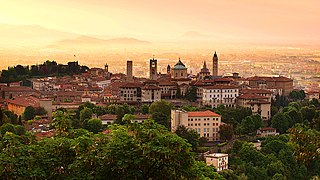
Bergamo is a city in the alpine Lombardy region of northern Italy, approximately 40 km (25 mi) northeast of Milan, and about 30 km (19 mi) from Switzerland, the alpine lakes Como and Iseo and 70 km (43 mi) from Garda and Maggiore. The Bergamo Alps begin immediately north of the city.
Tempietto generally means a small temple-like or pavilion-like structure and is a name of many places in Italy:

The Visigoths entered Hispania in 415 and they rose to be the dominant people there until the Umayyad conquest of Hispania of 711 brought their kingdom to an end.

One of the first streams of Romanesque architecture in Europe from the 10th century and the beginning of 11th century is called First Romanesque or Lombard Romanesque. It took place in the region of Lombardy and spread into Catalonia and into the south of France. Its principal decoration for the exterior, bands of ornamental blind arches are called Lombard bands. It was characterized by thick walls and lack of sculpture in facades, and with interiors profusely painted with frescoes.

Patti is a town and comune in northeastern Sicily, southern Italy, administratively part of the Metropolitan City of Messina, on the western shore of the gulf of the same name. It is located 76 kilometres (47 mi) from Messina.

Almenno San Salvatore is a comune (municipality) in the Province of Bergamo in the Italian region Lombardy, located about 45 kilometres (28 mi) northeast of Milan and about 9 kilometres (6 mi) northwest of Bergamo.

The Matris Domini Monastery is an enclosed female monastery which hosts the museum of the same name, situated in the lower part of the Italian city of Bergamo. It houses a museum featuring several medieval frescoes with religious themes.

The designation artede (la) repoblación was first proposed by José Camón Aznar in 1949 to replace the term Mozarabic as applied to certain works of architecture from the Christian kingdoms of northern Spain between the end of the 9th and beginning of the 11th centuries. Camón argued that these buildings were related stylistically to the architecture of Asturias and owed little to Andalusian styles. Moreover, since they were built by Christians living under Christian rule, neither were they Mozarabic.
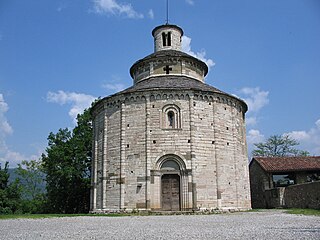
The Rotonda di San Tomè is a church in the comune (municipality) of Almenno San Bartolomeo, in the province of Bergamo, Lombardy, Northern Italy.

Nostra Signora di Tergu is a parish church in Tergu, province of Sassari, Sardinia, Italy. One of the most outstanding examples of Romanesque architecture in the island, the church and the remains of the annexed abbey are located in a countryside area outside the village.
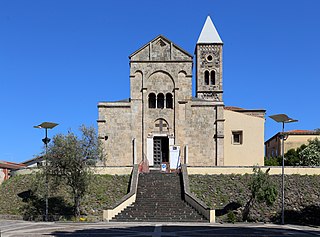
Santa Giusta Cathedral, now a minor basilica is the former cathedral of the abolished Diocese of Santa Giusta, in Santa Giusta, province of Oristano, Sardinia, Italy. The dedication is to Saint Justa of Cagliari who, according to the tradition, was martyred here at the time of the Roman emperor Diocletian, with her companions Saints Justina and Aenidina. Almost entirely built in sandstone, it is considered one of the most important examples of Sardinian Romanesque architecture.

Cagliari Cathedral is a Roman Catholic cathedral in Cagliari, Sardinia, Italy, dedicated to the Virgin Mary and to Saint Cecilia. It is the seat of the archbishop of Cagliari.

Romanesque architecture in Spain is the architectural style reflective of Romanesque architecture, with peculiar influences both from architectural styles outside the Iberian peninsula via Italy and France as well as traditional architectural patterns from within the peninsula. Romanesque architecture was developed in and propagated throughout Europe for more than two centuries, ranging approximately from the late tenth century until well into the thirteenth century.
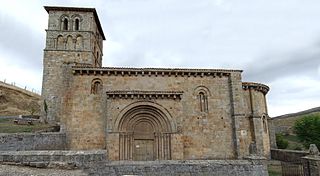
The Collegiate church of San Pedro de Cervatos is a collegiate church located in Campoo de Enmedio, Spain. The church was built around 1129. It has been protected by a heritage listing since 1895.

Sassari Cathedral is the Roman Catholic cathedral of Sassari, Sardinia, Italy, and is dedicated to Saint Nicholas. It is the seat of the Archbishop of Sassari. It was built in the Romanesque style in the 12th century. The present building also includes Gothic, Renaissance, Baroque and Neoclassical elements. Construction was finished in the 18th century.
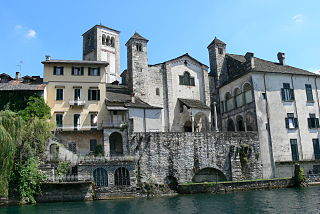
The Basilica di San Giulio is a Roman Catholic church on the small Isola San Giulio in the center of Lake Orta, province of Novara, north-western Italy. It has the status of a minor basilica. Although the island is part of the Orta San Giulio municipality, the basilica belongs to the San Giacomo parish, including the island and a portion of the west coast of the lake in San Maurizio d'Opaglio municipality.

San Nicola di Baraggiola is a Roman Catholic church located in the neighborhood of Baraggiola, in the town limits of Borgomanero, province of Novara, Piedmont, Italy.

San Bartolomeo is a church in Marne, Italy. It was an independent parish until the village of Marne became a municipality.

The Sardinian Romanesque is the Romanesque architectural style that developed in Sardinia. The Romanesque architecture in Sardinia has had a remarkable development since the early origins, during the Giudicati era, and for a long period. His expressions, although autonomous, are not classifiable in a recognizable image, since in the island the Romanesque manifested itself with unusual results but in numerous forms; this is due to the establishment in Sardinia of several religious orders, coming from various Italian regions and from France. Consequently, in the architectures of that era Pisan, Lombard and Provençal influences are recognizable as well as traces of the passage of workers, coming from the Iberian Peninsula, of Islamic culture.
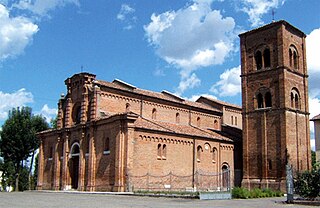
The pieve of Our Lady of the Snows is a Romanesque church located in Quarantoli, village near Mirandola, in the province of Modena and Roman Catholic Diocese of Carpi.



















